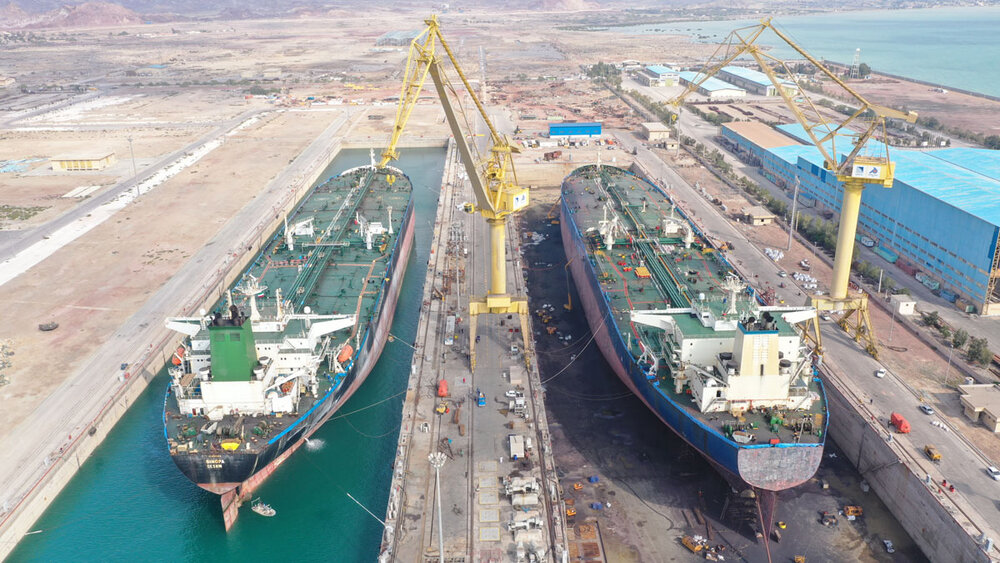Iran’s shipbuilding: an old but newly developing industry

TEHRAN - Iran's shipbuilding industry, with more than 50 years of history, has been on a journey toward development since its establishment, and nowadays the Islamic Republic is considered one of the world’s major shipbuilders, manufacturing and repairing all kinds of giant vessels.
However, despite all the improvement achieved in the shipbuilding industry over the past few years, there are still many challenges in the way of this old but newly developed industry which calls for special attention.
Modernizing the shipbuilding industry is not only a commercial necessity but also a must for the Islamic Republic as the country heavily relies on its oil industry whose existence is dependent on ocean-going vessels.
As a vital sector in Iran’s shipbuilding industry, repairing must also be given special significance, since for many years Iranian oil tankers and large cargo vessels have been sent to foreign yards for periodic overhauls and this has imposed huge costs on the country’s economy.
History of modern shipbuilding in Iran
Considering Iran’s special geographical position in the region and its shared borders with several coastal countries both in the south and north, shipbuilding has always been among the major industries strongly entangled with the country’s economy.
As Iran’s first modern shipbuilding complex, the Iran Marine Industrial Company, also known as SADRA, was established in 1968 as a small ship repair yard in Bushehr Province, southern Iran. Since then, the company has developed into a major shipbuilding and ship-repairing company in Iran and in the region.
Later in 1973, Iran Shipbuilding and Offshore Industries Complex (ISOICO), which is a subsidiary of the Industrial Development and Renovation Organization of Iran (IDRO), was established as the largest shipbuilding complex in West Asia, in an area of 1100 hectares, 37 kilometers west of the southern port of Bandar Abbas.
At the initial stage, the complex was established with the aim of creating facilities for repairing small and medium-sized vessels. Later, the complex’s equipment and facilities were developed for the construction and repair of large tankers.
Recent developments
In July 2019, ISOICO successfully finished the overhaul operation of a supertanker for the first time inside the country. Iranian technicians managed to repair the oil supertanker “DORE” inside the country for the first time in the history of Iran’s shipping industry.
Following the successful overhaul of the mentioned supertanker, major domestic ship-owners like the National Iranian Tanker Company (NITC) and the Islamic Republic of Iran Shipping Lines (IRISL), started referring a major part of their overhaul operations to local yards in order to reduce their costs and also to encourage domestic yards to expand their works.
Following the footsteps of the country’s two major shipbuilders, new private companies have also entered the sector over the past few years, making the industry expand its roots both inside the country and at the global level.
According to Saeid Jafari, the director-general of the maritime industry department at the Ministry of Industry, Mining and Trade, there are currently 23 yards active in the country which are able to fully meet the needs in this sector.
In addition to repair operations, Iranian shipbuilding companies have also successfully built three large oil tankers for Venezuela.
In September 2022, Venezuelan President Nicolas Maduro announced receiving the third "advanced" oil tanker from Iran as part of a bilateral arrangement.
“We have just received another ship with the most advanced engineering and technology in the world,” Maduro said according to Venezuelan state TV. He said that the ship was manufactured by Iran upon Venezuela’s order.
Also, in late December 2022, Head of the SADRA Company’s Caspian Complex Meysam Ra'yat Azad said the company is currently repairing a Russian vessel that has hit large pieces of ice in the Volga River.
This is the first time that a Russian vessel is being repaired by Iran Marine Industrial Company, the official said.
Specialists of the SADRA company are currently trying to fix some of the damages caused to this bulk ship, he added.
Requirements for further development
Considering all the improvements in Iran’s shipbuilding industry, the sector still has a long way ahead to reach its full potential. The first step in this regard is to develop infrastructure and train more specialized and skilled manpower.
Marginal issues such as customs and clearance problems, etc. should also be seriously considered in order to lure in foreign customers and expand activities at an international level.
Measures should also be taken for all ship repair operations to be carried out in one place. Sometimes a part of the overhaul is carried out in a yard, but due to the lack of infrastructure, skill, or equipment other parts are referred to foreign companies. In this case, the ship owner must spend twice the port fees, the cost of transportation, and most importantly the time for the ship to get ready.
Another important factor that should be taken into consideration is marketing. Shipbuilding yards in Iran are mostly focused on repairing or building ships for domestic companies like NITC and IRISL, however, these companies have only a limited number of orders every year. Iranian shipbuilding yards need to get more orders since more work means more revenue and more money would lead to more development.
EF/MA
